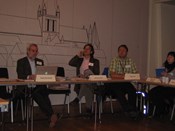|
First international Conference
ADAPTING COMMUNITY RISK AND VULNERABILITY ANALYSES FOR CLIMATE CHANGE AdaptCRVA-CONFERENCE IN TRONDHEIM, JANUARY 22-23, 2008 SUMMARY OF THE CONFERENCE
________________________________________
TITLES OF THE PRESENTATIONS
________________________________________
The key note speaker Paul Weaver from the Wolfson Research Institute in Durham, U.K., defined the terms “mainstreaming”, “transformative” and “vulnerability assessment”. He pinpointed that there is a need for a common language and a conceptual common framework. Several different methods like vulnerability index and maps, livelihood sensitive approaches, scenarios, syndromes and integrated vulnerability and agent-based models can be used for the implementation of integrated assessment methodologies.
________________________________________
Elisabeth Krausmann of the Joint Research Centre of the European Comission in Ispra, Italy presented NEDIES, a Natural and Environmental Disaster and Information Exchange System, which provides general disaster information, risk reduction measures, multi-hazard analyses and risk mapping.
________________________________________
Britt-Marie Drottz-Sjöberg from the Department of Psychology at the University Trondheim talked about lessons, which were learned from five different research projects, which included following topics:
Participatory appraisal of climate change adaptation in three regions of the world, Experiences from the ADAM project
David Tàbara from the Institute of Environmental Sciences and Technology at the Autonomous University of Barcelona provide some insights from the EU project ADAM, Adaptation and Mitigation Strategies: supporting European climate policy. The project includes 8 work packages, 26 partner institutes, 35 deliverables and around 90 researchers over a period of three years. The objectives of ADAM are:
________________________________________ Adaptation for climate change. Resilient strategies for managing the unexpected
Jan Hovden, form the Department of Industrial Economics and Technology Management at the University Trondheim, spoke about “Adaptation to climate change. Resilient strategies for managing the unexpected.” He exemplified the challenge of climate change adaptation, the interrelation between adaptation, mitigation and impacts, sources of societal vulnerabilities, risk classification and risk management strategies.
________________________________________ Flood risk assessment under climate change
Paolo Burlando form the chair of Hydrology and Water Resource Management from the Institute of Environmental Engineering at the ETH Zurich presented a part of his research under the title “Flood risk assessment under climate change”. Results from Case studies for rainfalls and floods in Central Italy and the Alps indicate significant changes of the rainfall internal structure, significant changes of extremes and associated return periods of rainfalls. Furthermore there is a general increase for future flood risks and a specific increase of volumes and duration. The implications for adaptation are among other things for example, that there is a need to focus on a mid-term rather than a long-term, that the structural flood defence must account for different design procedures and the risk acceptance and management have to change to cope with increased magnitude of high and mid frequency events. The changes of the rainfall regime and of flood frequency and magnitude may lead to more collateral risks. Flood risk management should be a part of integrated water resources management.
________________________________________ Risk perception and communication
Anthony Patt from the International Institute of Applied Systems Analysis in Laxenburg, Austria introduced us to two projects about “Risk (and vulnerability) perception and communication in Africa and to a European project called ATEAM . The project on the Limpopo River Floodplain in Mozambique bespoke the importance of risk understanding: ”Helping people managing risk doesn’t work unless it’s coupled with a process to understand them. And helping people to understand risk doesn’t work unless it’s coupled wit a process to manage them.”
________________________________________ Practical considerations for mainstreaming and transformative risk and vulnerability analysis
James Rydock from Research Management AS, Trondheim, provided at the beginning of his talk an interesting definition for the terms “mainstreaming and transformative” in association with risk and vulnerability analyses.
At the end of the conference James was so kind to provide an overview about all the interesting talks of the last tow days.
Once again a special thanks to the invited speakers and the attendees of the conference for their engagement and the great conference! |

Information about the conference
| |